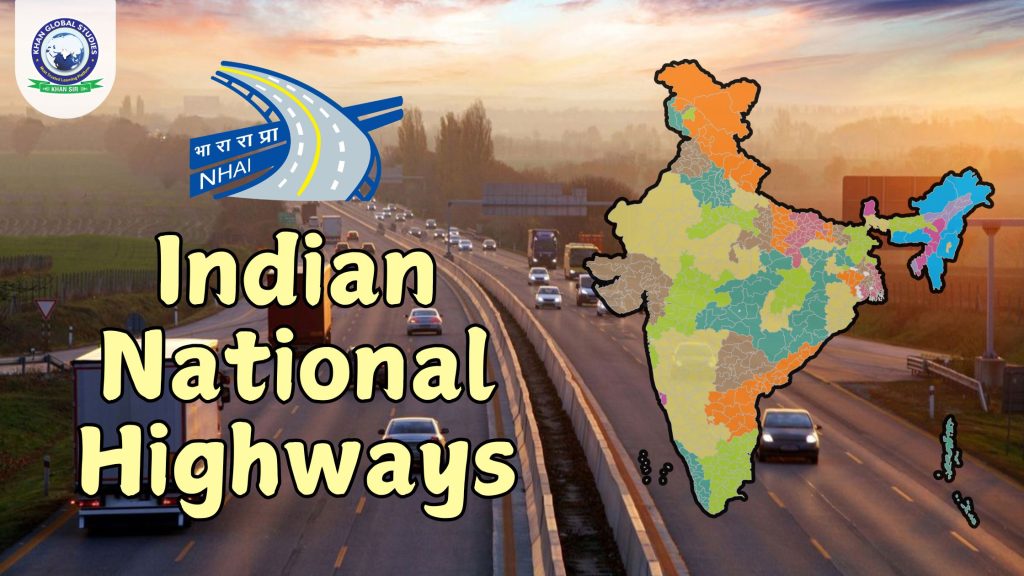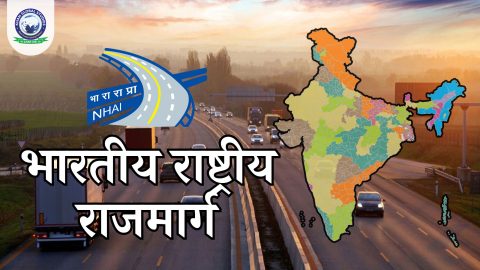The National Highways (NH) of India are the backbone of the country’s transportation system, connecting various states, cities and villages. These roads are not only important for economic activities but also play a vital role in facilitating social and cultural exchange. These highways are maintained, developed and regulated primarily by the Ministry of Road Transport and Highways (MoRTH).
History of National Highways in India
The history of national highways in India is linked to the British era when the foundation of the road network was laid. However, after gaining independence in 1947, the Government of India emphasized the development of infrastructure, including roads. A major milestone came in 1998 with the launch of the National Highways Development Project (NHDP), which aimed to enhance connectivity between major economic centers of India through improved road networks.
Definition of National Highways
National highways are defined as roads that connect different states within the country or lead to an international border, port or major tourist destination. They are designed not only for commercial traffic but also for strategic military use. These highways are considered vital for the transportation of goods and services, making them important for the country’s economy.
Number and Length of National Highways
By 2024, India’s national highways are projected to exceed 144,000 kilometers in length, passing through almost all the important regions of the country. Despite covering only 2% of India’s total road network, these highways handle about 40% of the country’s traffic. This disproportionate burden on national highways underlines their importance in maintaining India’s logistics and transportation flow.
Major National Highways
Several major national highways form the backbone of India’s transportation grid. Some of the most important of these are:
- NH-44 (formerly NH-7): Stretching from Srinagar in the north to Kanyakumari in the south, it is the longest national highway in India, spanning about 3,745 km. It plays a vital role in connecting the northern and southern parts of India. NH-16: Running along the east coast of India, this highway connects Kolkata in West Bengal to Chennai in Tamil Nadu, connecting several important coastal cities.
- NH-48: Connecting the country’s capital Delhi to its financial hub Mumbai, NH-48 is a vital corridor that supports major economic activities in western and central India.
Numbering System of National Highways
In 2010, the Government of India revamped the numbering system of national highways to create a more organized and logical system. Under this new numbering scheme:
- Highways running from north to south are given even numbers.
- Highways running from east to west are given odd numbers.
Smaller, branch highways are indicated by adding a suffix such as A or B to the main highway number. For example, a branch of NH-44 may be named NH-44A.
Maintenance and Management of National Highways
The construction and maintenance of national highways is primarily the responsibility of the National Highways Authority of India (NHAI) and the Ministry of Road Transport and Highways (MoRTH). Funding for the maintenance of these roads is often supported by toll collection, ensuring that the highways remain in good condition. The toll system also helps raise funds for future expansion and improvements.
Bharatmala Project: The Future of India’s National Highways
In 2017, the government launched the ambitious Bharatmala Project, which aims to expand and upgrade India’s highway infrastructure. The project focuses on developing border areas, economic corridors, ports, and industrial areas by linking them through a robust network of highways. The Bharatmala initiative is expected to enhance national and regional connectivity and boost economic growth across India.
Traffic and Safety on National Highways
India’s national highways carry some of the heaviest traffic flows in the world. To address the related challenges, various safety measures have been implemented, including improved road engineering, FASTag systems at toll plazas, and increased availability of emergency services on major routes. The goal is to reduce congestion, enhance road safety, and streamline transportation.
Challenges Faced by National Highways
Despite the rapid expansion and improvement of the national highway network, several challenges remain:
- Traffic Congestion: Many highways, especially near urban centers, suffer from severe traffic congestion due to high vehicle density.
- Road Accidents: India has one of the highest rates of road accidents worldwide, with many of the accidents occurring on national highways. Poor driving habits, lack of safety awareness, and inadequate road infrastructure in some areas contribute to this problem.
- Natural Disasters: National highways are often affected by floods, landslides, and other natural disasters, especially in areas with extreme weather conditions.
Conclusion
India’s national highways serve as a vital link connecting the country’s diverse regions, promoting economic growth, cultural exchange, and social cohesion. With government initiatives such as the National Highway Development Project and the Bharatmala Pariyojana, the infrastructure supporting these highways is constantly evolving to meet the demands of a rapidly developing nation. As India continues to expand its highway network, the future of its transportation system looks brighter than ever.





